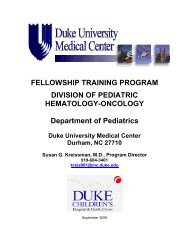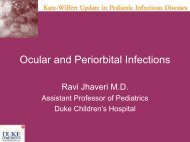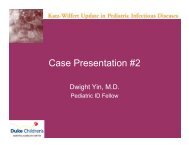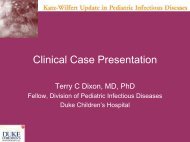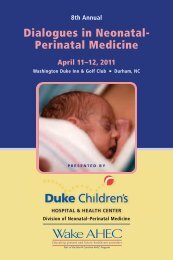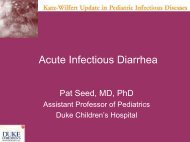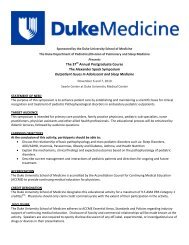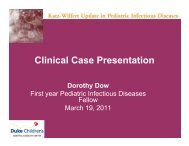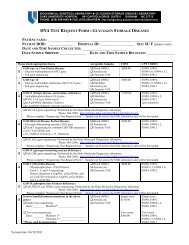Pediatric Pharmacokinetics - Duke Pediatrics Intranet
Pediatric Pharmacokinetics - Duke Pediatrics Intranet
Pediatric Pharmacokinetics - Duke Pediatrics Intranet
- No tags were found...
You also want an ePaper? Increase the reach of your titles
YUMPU automatically turns print PDFs into web optimized ePapers that Google loves.
<strong>Pediatric</strong> <strong>Pharmacokinetics</strong>:Why Children Are Not Little AdultsRoss McKinney M.D.Vice-Dean for Research<strong>Duke</strong> University School of Medicine
<strong>Pediatric</strong> Dosing• All pediatricians know dosinginformation is limited• Traditionally, for less frequently useddrugs, extrapolation is done from adultdose on a weight or surface area basis
Problems• Absorption may be more or less thanadult• Clearance of some drugs in children isaffected by maturation, as well as size– Cytochrome P450 enzyme system maturesover time– Glomerular filtration changes over time• Drug targets may vary with age
Absorption• Intraluminal pH changes over time– High in neonatal period (achlorhydria)• Increases bioavailability of acid labilecompounds• Weak acids may require larger doses(phenobarbitol)– Gastric emptying slower in neonatal period• “Normal” by about 4 months• Some oral drugs slower to reach peakconcentrations in neonates
Absorption - 2• Villous formation initially limited – lessabsorption surface• Intestinal CYP 1A1 increases with age• Re: topical skin drugs, thinner skin andhigher body surface area to volume ratiomakes children susceptible toabsorption effects– Steroid use on eczema – growthsuppression– PhisoHex soap
Distribution• Neonates and Infants have relativelyhigh proportion of body water.• Plasma proteins change (for example,fetal albumin has less affinity for weakacids than adult)
1 Yr5 Yr10 Yr20 Yr40 Yr9 Mo6 Mo3 MoBirth1009080706050403020100ProportionsTotal WaterBody FatAgeFrom Kearns, et al, NEJM 2003% Total Body Weight
Metabolism• Two phases of hepatic metabolism– Phase I – oxidation– Phase II – conjugation• Phase I done by Cytochrome P-450(CYP)• CYP 3A7 very high in fetal liver, gone inadulthood – detoxifies anabolic steroids& retinoic acid breakdown products(which happen to be teratogenic)
CYP Enzymes• CYP isoforms vary with age• For example, clearance of midazolam byCYP 3A4 and 3A5 goes from 1.2ml/min/kg to 9 ml/min/kg over first fewmonths of life• Carbamezapine (3A4) clearance fasterin children than adults – requires higherdoses
Renal Clearance• GFR increases until around 8-12 monthsof life• Tubular secretion reaches adult capacityduring first year of life• Illustrations would includeaminoglycosides and beta-lactam drugs
Glomerular Filtration Rate (GFR) by Age700600ml/min/1.73 m250040030020010001-2 D 2-4 Wk 2 Mo 6 Mo 1 Yr 2 Yr 6 Yr 12 Yr
Renal Clearance• As a result of the low initial GFR, renallyexcreted drugs are dosed lessfrequently
Targets – non-Host• Antibiotics target an organism, whichmeans the critical issues are arounddrug concentrations in theaffected/infected tissue• Need to pay attention to dosedependent and time dependent killing
Host Targets• Some host targets change with age– ?serotonin receptors– Intestinal motilin receptors (erythromycin GIeffects)– Responses to sympatheticomimetic drugsin bronchospasm
Formulations• Not all meds can be made into liquids• Some liquid meds taste terrible• Bioavailability problems– Efavirenz as an example• Some vehicles may be toxic
Interactions• Given varying metabolic & clearancerates, interactions may be hard topredict• Some drugs affect metabolism by CYPsystem– Recently discovered ritonavir increasesFlonase (fluticasone) levels – increasedsteroid side effects
Summary• The catchphrase is, “Children are notSmall Adults”• The catchphrase is true….



